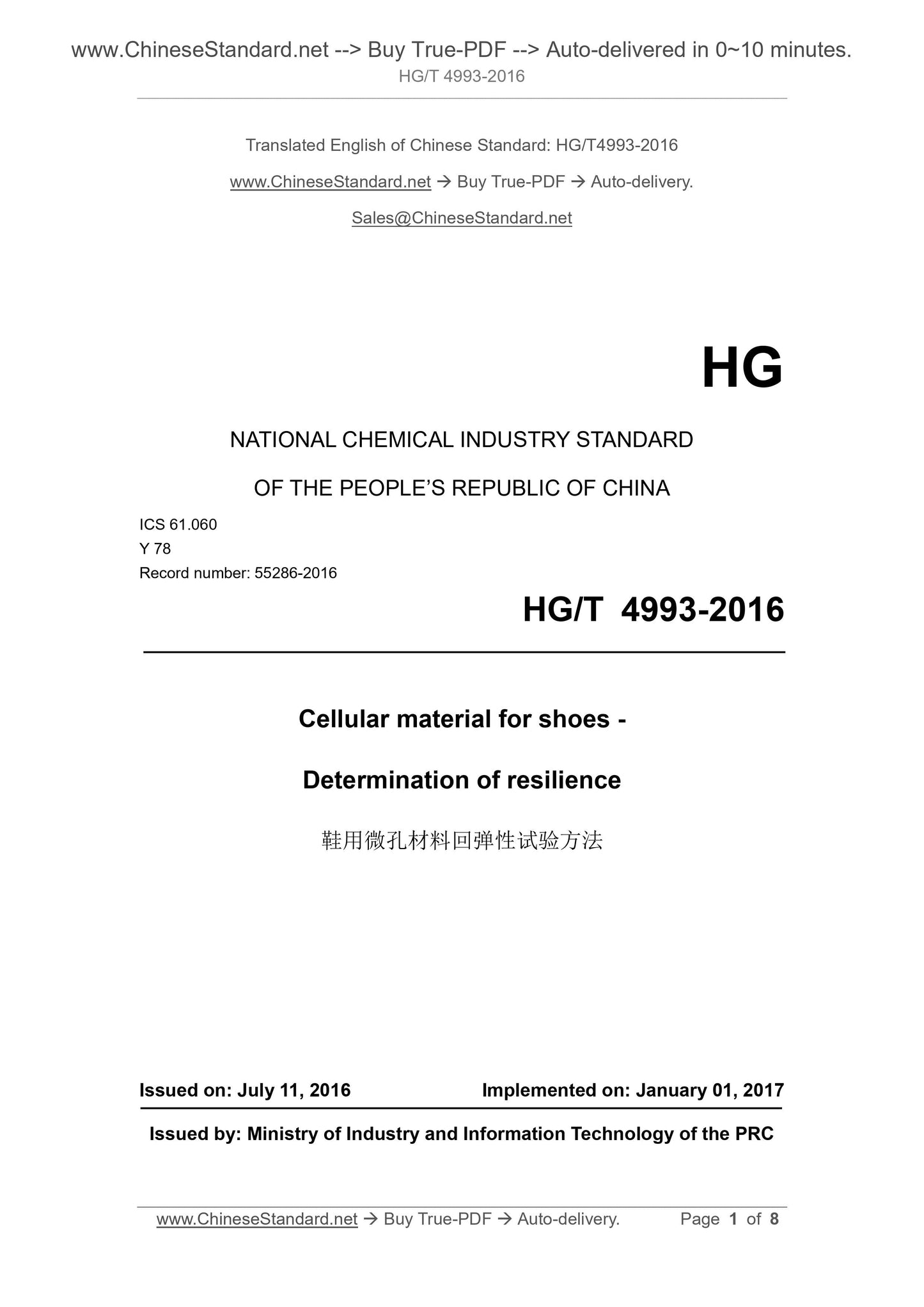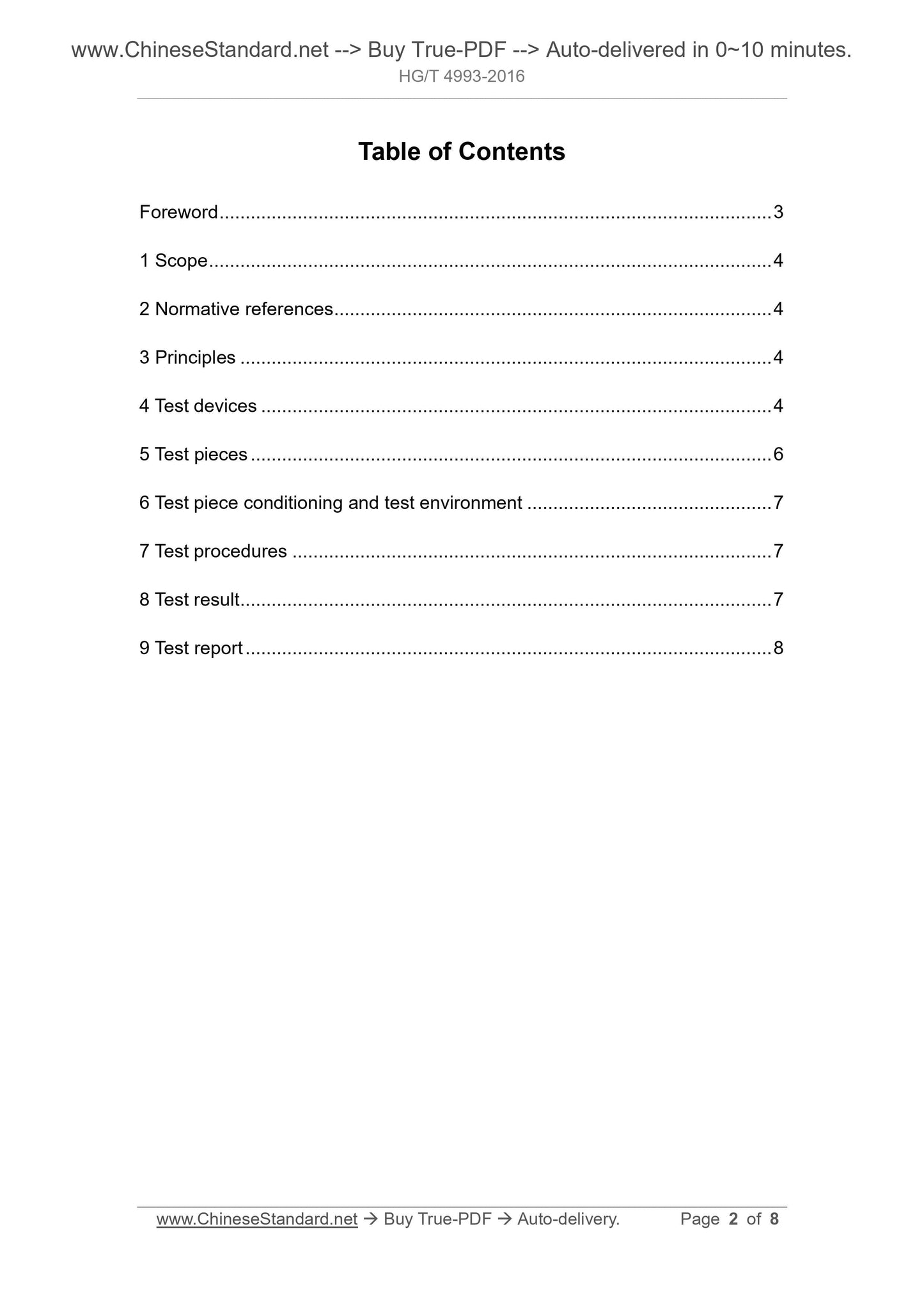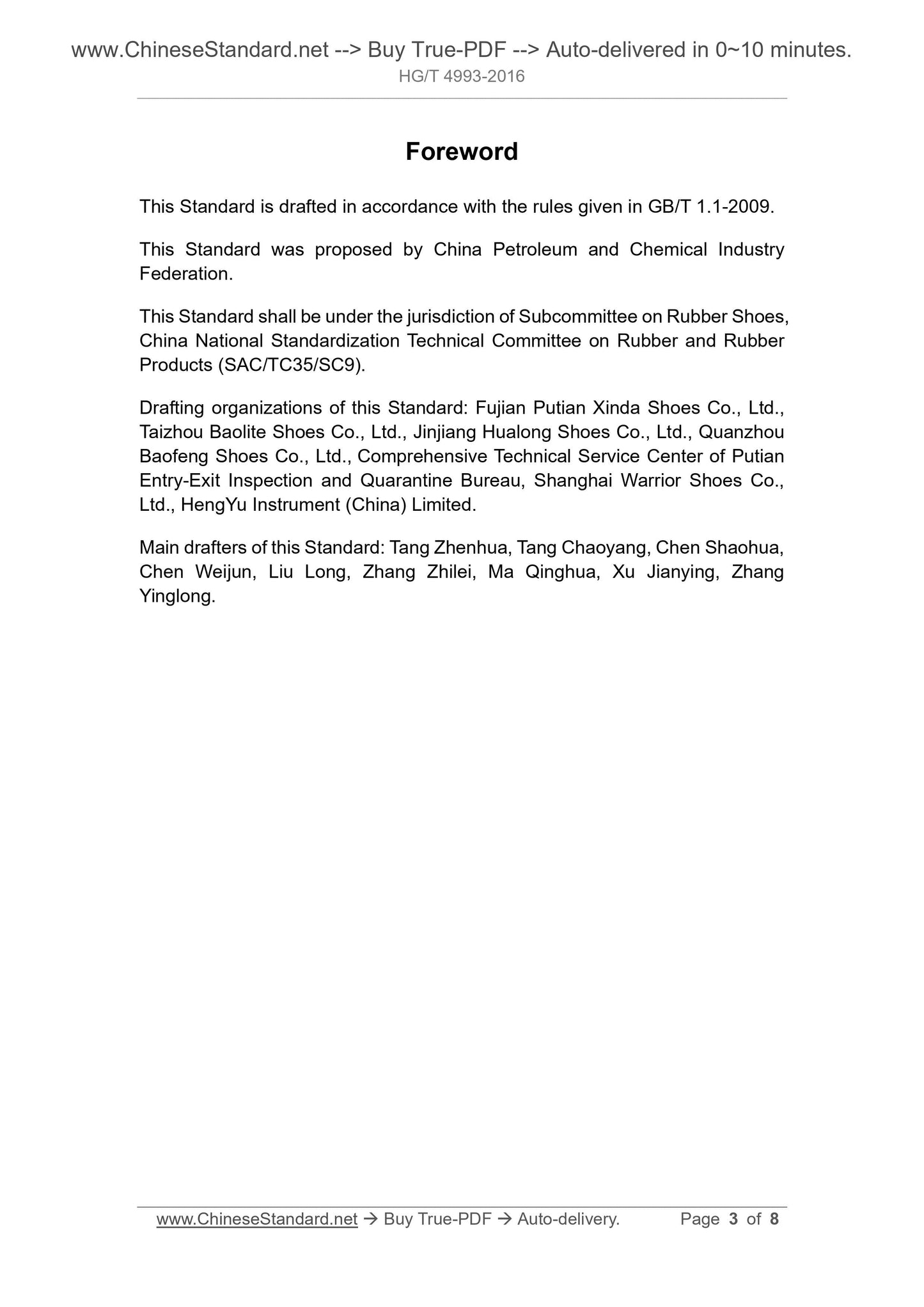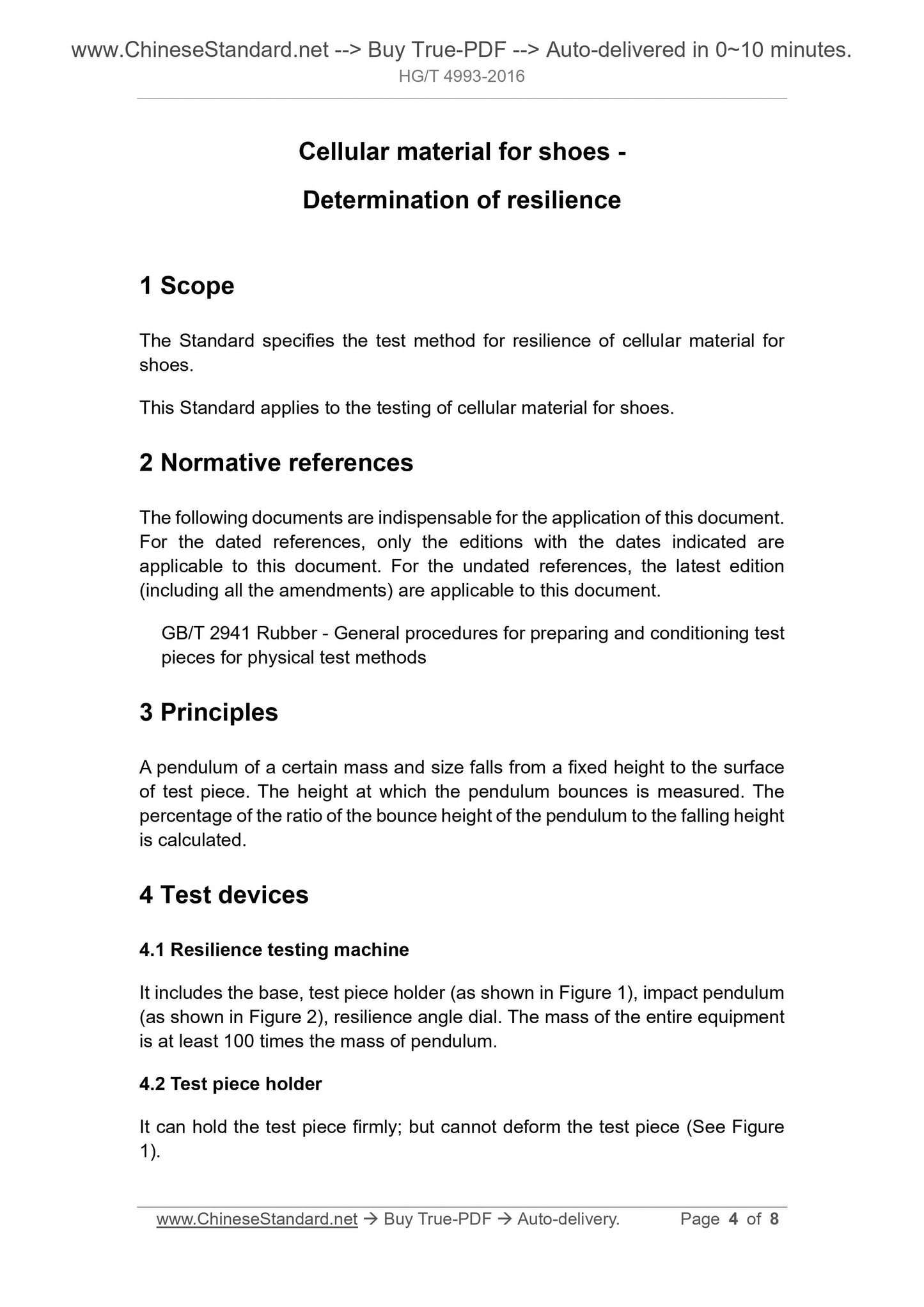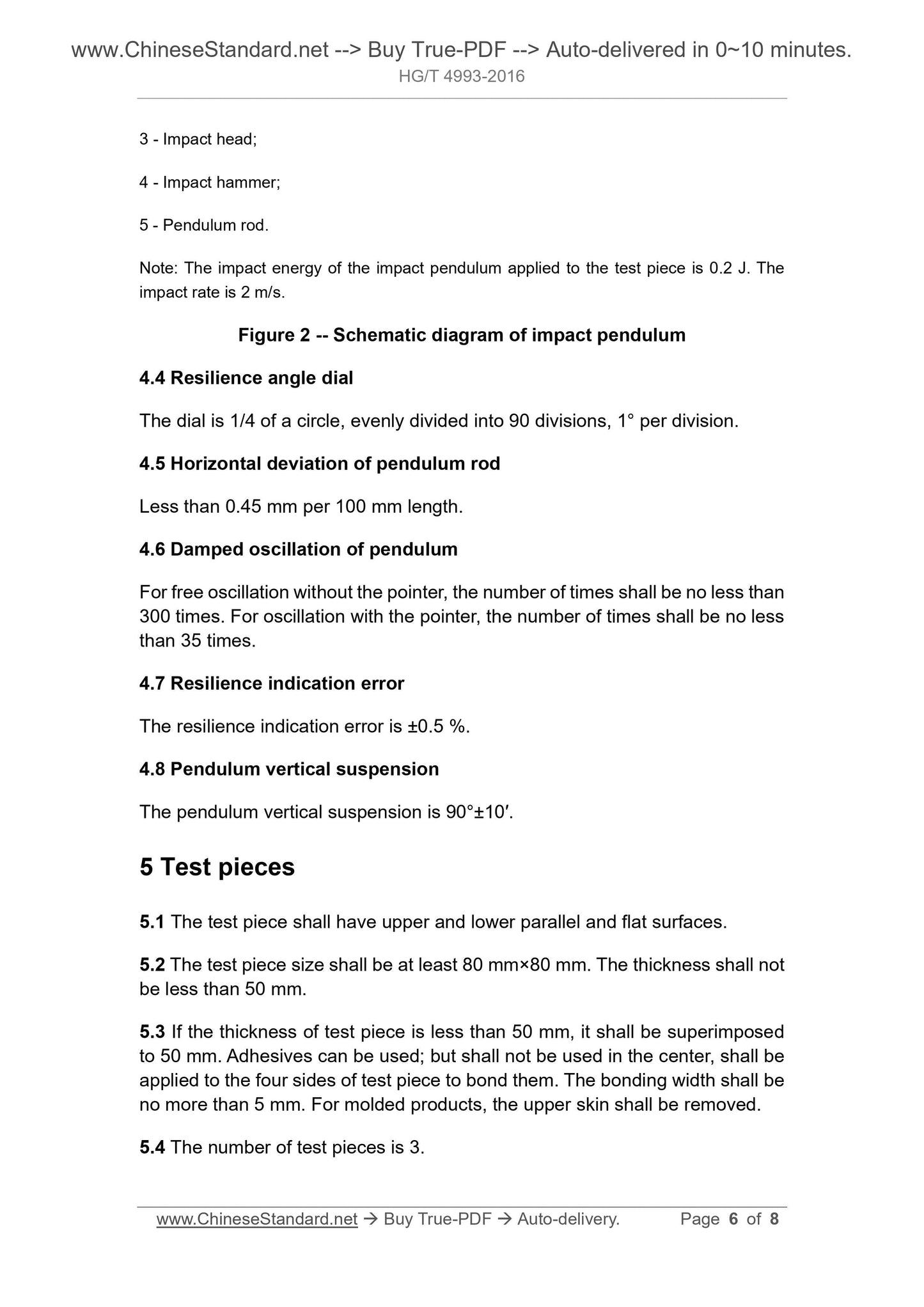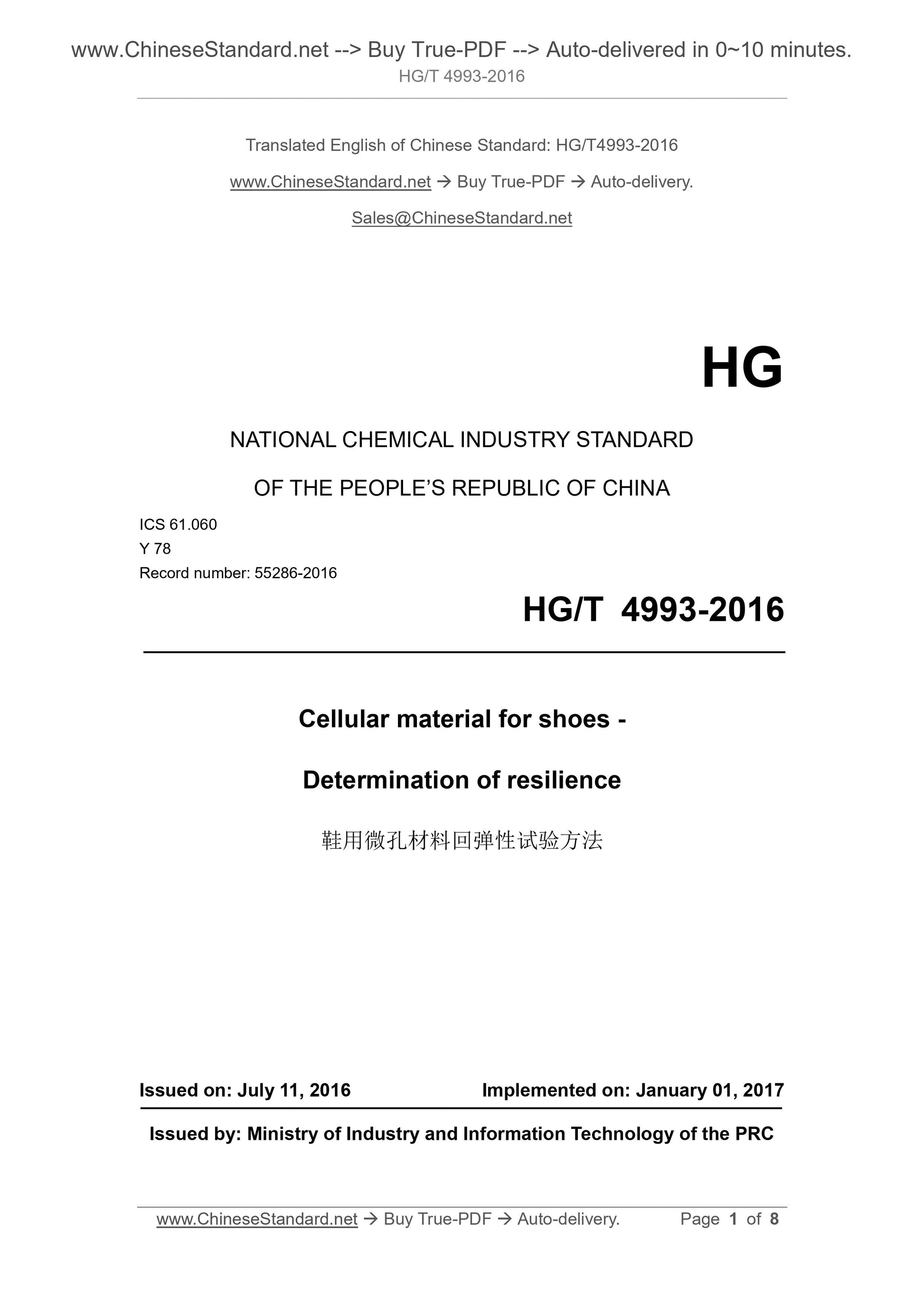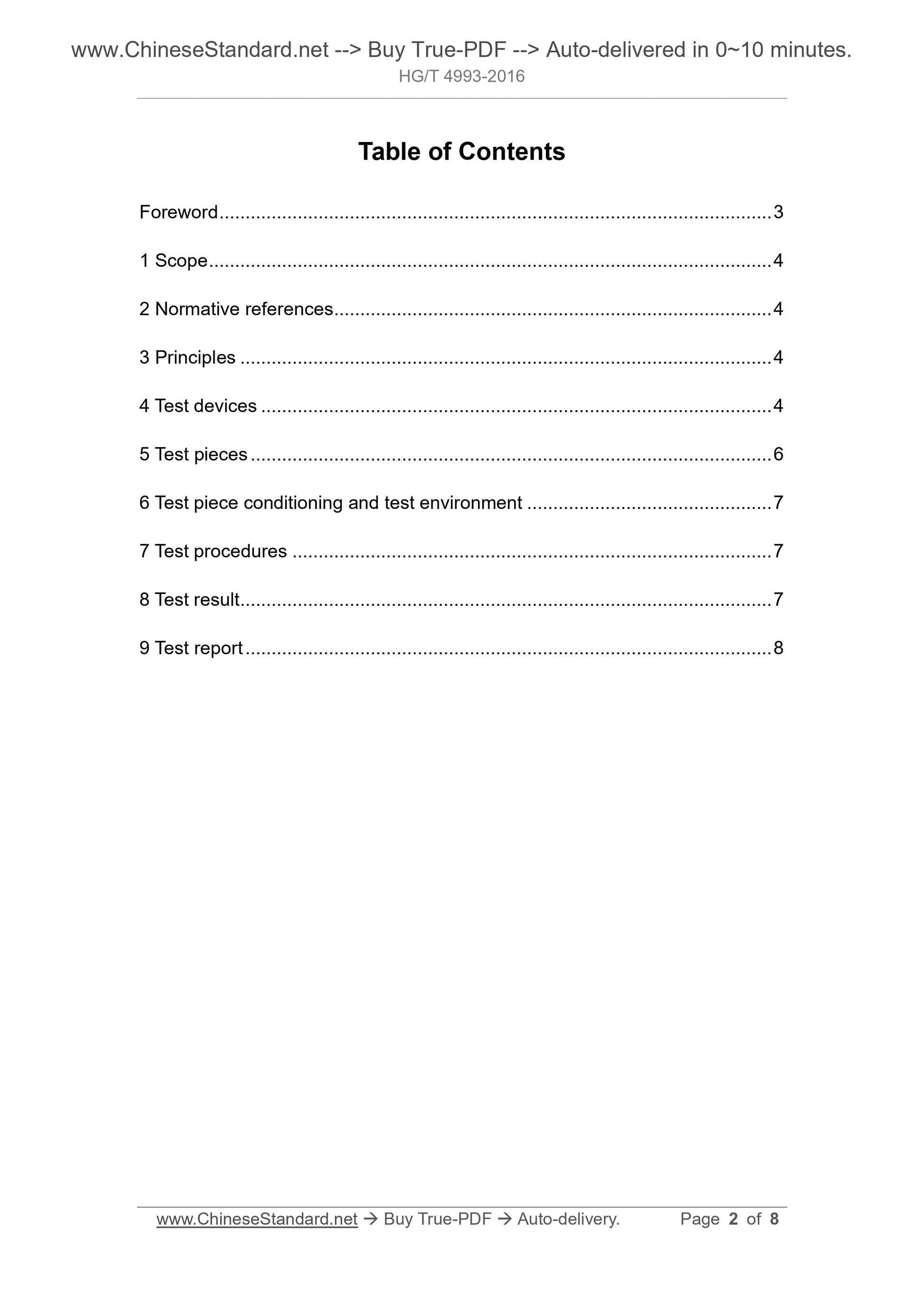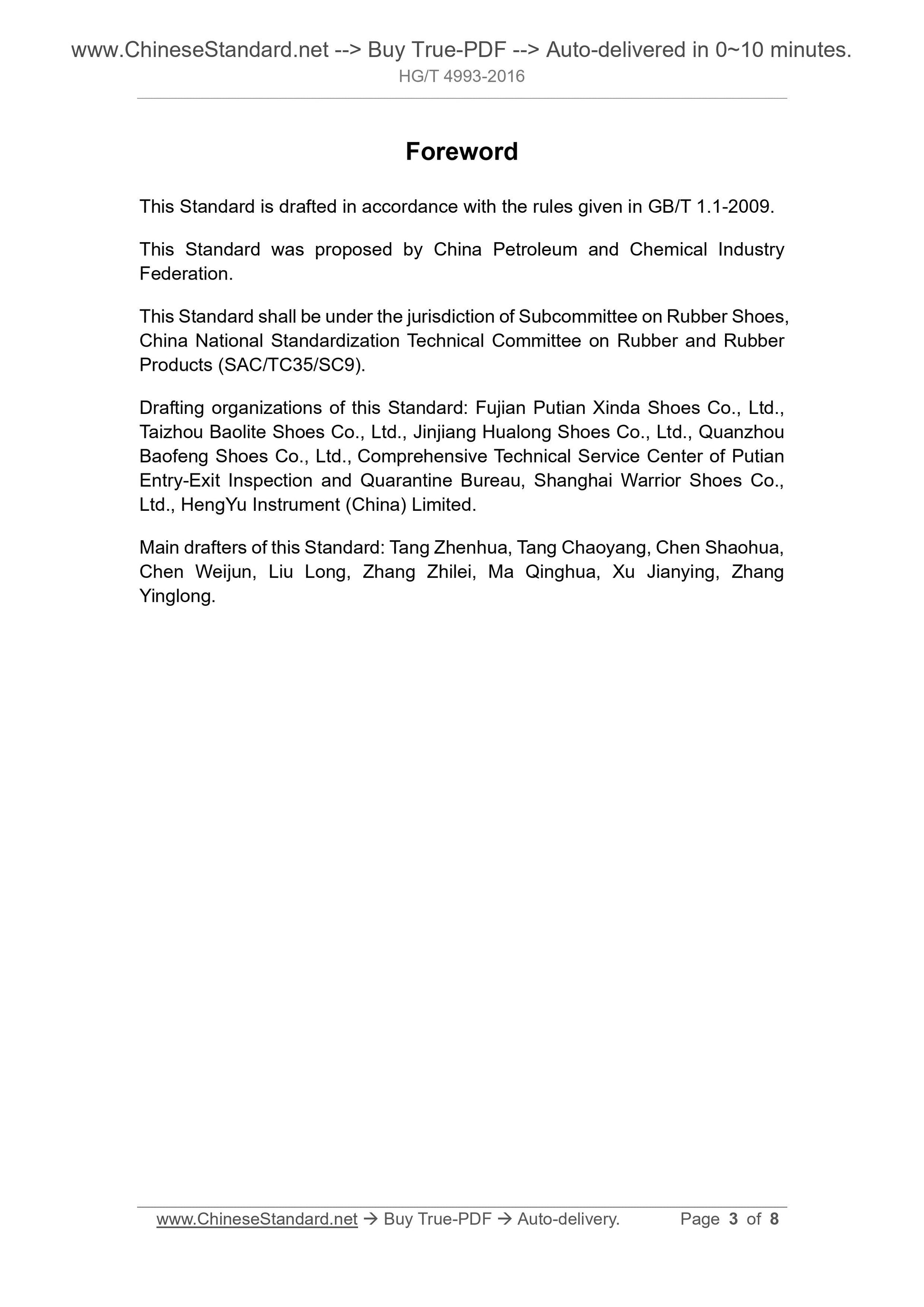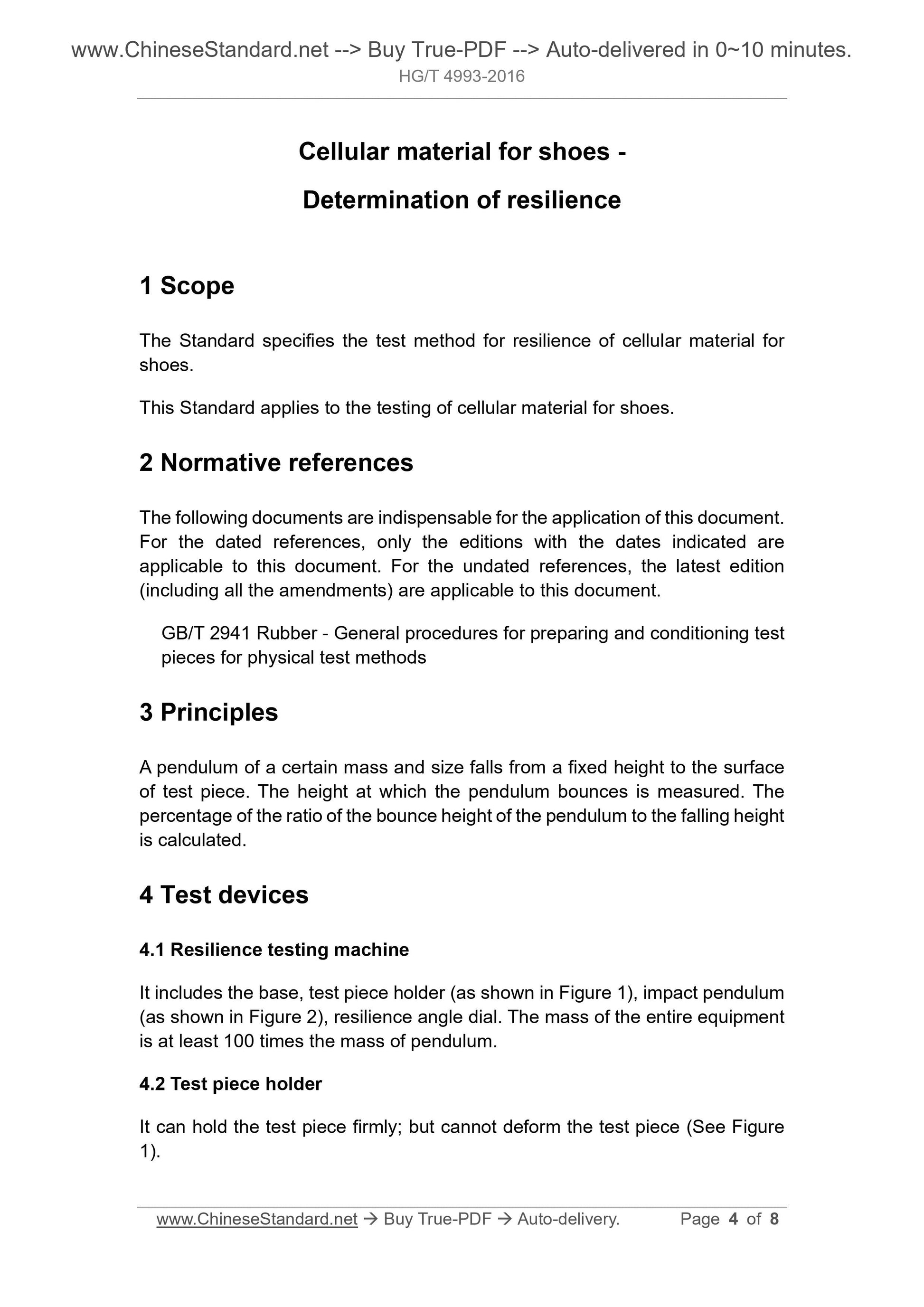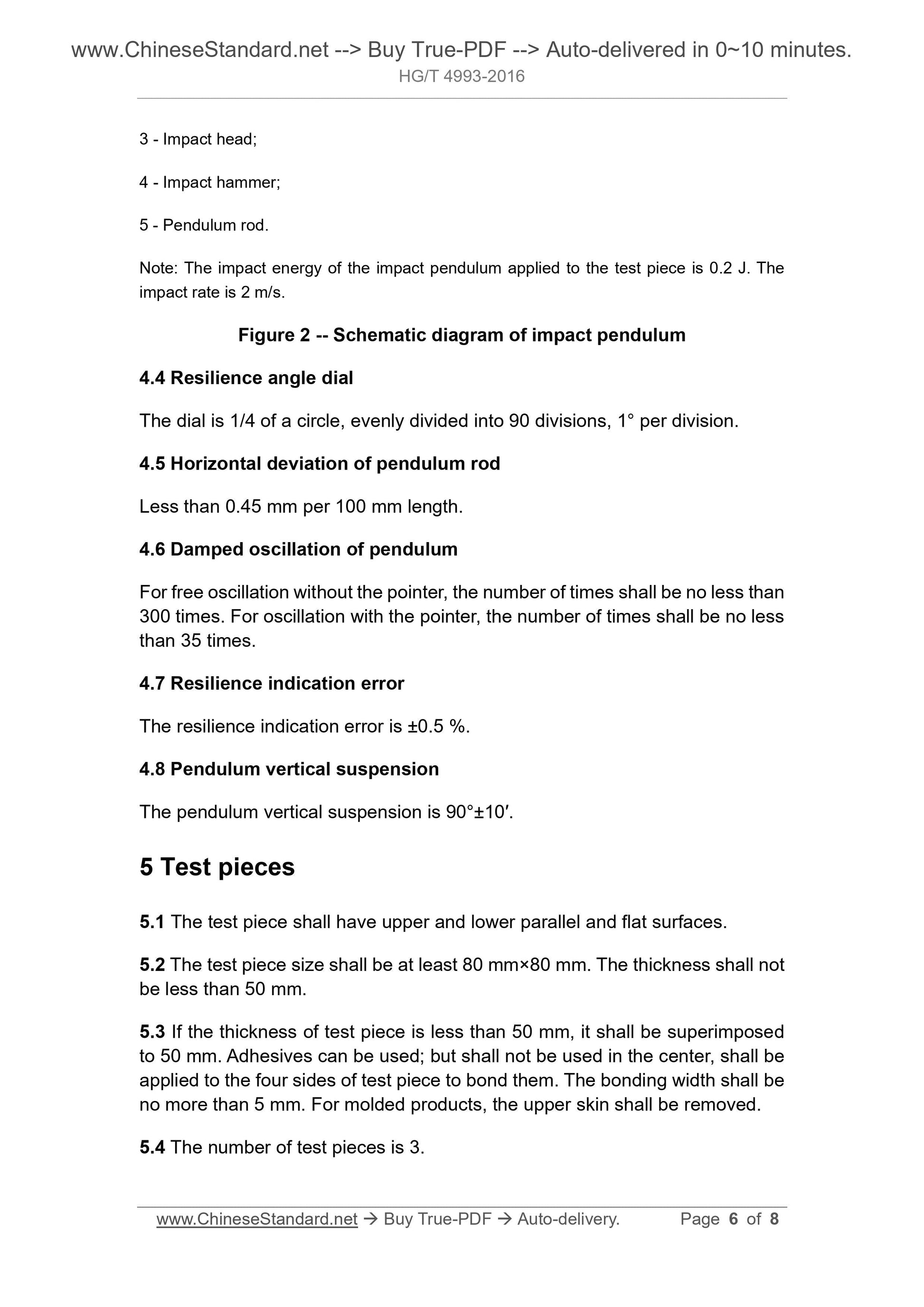1
/
of
5
PayPal, credit cards. Download editable-PDF and invoice in 1 second!
HG/T 4993-2016 English PDF (HG/T4993-2016)
HG/T 4993-2016 English PDF (HG/T4993-2016)
Regular price
$90.00 USD
Regular price
Sale price
$90.00 USD
Unit price
/
per
Shipping calculated at checkout.
Couldn't load pickup availability
Delivery: 3 seconds. Download true-PDF + Invoice.
Get QUOTATION in 1-minute: Click HG/T 4993-2016
Historical versions: HG/T 4993-2016
Preview True-PDF (Reload/Scroll if blank)
HG/T 4993-2016: Cellular material for shoes. Determination of resilience
HG/T 4993-2016
HG
NATIONAL CHEMICAL INDUSTRY STANDARD
OF THE PEOPLE’S REPUBLIC OF CHINA
ICS 61.060
Y 78
Record number. 55286-2016
Cellular material for shoes -
Determination of resilience
ISSUED ON. JULY 11, 2016
IMPLEMENTED ON. JANUARY 01, 2017
Issued by. Ministry of Industry and Information Technology of the PRC
Table of Contents
Foreword ... 3
1 Scope ... 4
2 Normative references ... 4
3 Principles ... 4
4 Test devices ... 4
5 Test pieces ... 6
6 Test piece conditioning and test environment ... 7
7 Test procedures ... 7
8 Test result ... 7
9 Test report ... 8
Foreword
This Standard is drafted in accordance with the rules given in GB/T 1.1-2009.
This Standard was proposed by China Petroleum and Chemical Industry
Federation.
This Standard shall be under the jurisdiction of Subcommittee on Rubber Shoes,
China National Standardization Technical Committee on Rubber and Rubber
Products (SAC/TC35/SC9).
Drafting organizations of this Standard. Fujian Putian Xinda Shoes Co., Ltd.,
Taizhou Baolite Shoes Co., Ltd., Jinjiang Hualong Shoes Co., Ltd., Quanzhou
Baofeng Shoes Co., Ltd., Comprehensive Technical Service Center of Putian
Entry-Exit Inspection and Quarantine Bureau, Shanghai Warrior Shoes Co.,
Ltd., HengYu Instrument (China) Limited.
Main drafters of this Standard. Tang Zhenhua, Tang Chaoyang, Chen Shaohua,
Chen Weijun, Liu Long, Zhang Zhilei, Ma Qinghua, Xu Jianying, Zhang
Yinglong.
Cellular material for shoes -
Determination of resilience
1 Scope
The Standard specifies the test method for resilience of cellular material for
shoes.
This Standard applies to the testing of cellular material for shoes.
2 Normative references
The following documents are indispensable for the application of this document.
For the dated references, only the editions with the dates indicated are
applicable to this document. For the undated references, the latest edition
(including all the amendments) are applicable to this document.
GB/T 2941 Rubber - General procedures for preparing and conditioning test
pieces for physical test methods
3 Principles
A pendulum of a certain mass and size falls from a fixed height to the surface
of test piece. The height at which the pendulum bounces is measured. The
percentage of the ratio of the bounce height of the pendulum to the falling height
is calculated.
4 Test devices
4.1 Resilience testing machine
It includes the base, test piece holder (as shown in Figure 1), impact pendulum
(as shown in Figure 2), resilience angle dial. The mass of the entire equipment
is at least 100 times the mass of pendulum.
4.2 Test piece holder
It can hold the test piece firmly; but cannot deform the test piece (See Figure
1).
3 - Impact head;
4 - Impact hammer;
5 - Pendulum rod.
Note. The impact energy of the impact pendulum applied to the test piece is 0.2 J. The
impact rate is 2 m/s.
Figure 2 -- Schematic diagram of impact pendulum
4.4 Resilience angle dial
The dial is 1/4 of a circle, evenly divided into 90 divisions, 1° per division.
4.5 Horizontal deviation of pendulum rod
Less than 0.45 mm per 100 mm length.
4.6 Damped oscillation of pendulum
For free oscillation without the pointer, the number of times shall be no less than
300 times. For oscillation with the pointer, the number of times shall be no less
than 35 times.
4.7 Resilience indication error
The resilience indication error is ±0.5 %.
4.8 Pendulum vertical suspension
The pendulum vertical suspension is 90°±10′.
5 Test pieces
5.1 The test piece shall have upper and lower parallel and flat surfaces.
5.2 The test piece size shall be at least 80 mm×80 mm. The thickness shall not
be less than 50 mm.
5.3 If the thickness of test piece is less than 50 mm, it shall be superimposed
to 50 mm. Adhesives can be used; but shall not be used in the center, shall be
applied to the four sides of test piece to bond them. The bonding width shall be
no more than 5 mm. For molded products, the upper skin shall be removed.
5.4 The number of test pieces is 3.
Get QUOTATION in 1-minute: Click HG/T 4993-2016
Historical versions: HG/T 4993-2016
Preview True-PDF (Reload/Scroll if blank)
HG/T 4993-2016: Cellular material for shoes. Determination of resilience
HG/T 4993-2016
HG
NATIONAL CHEMICAL INDUSTRY STANDARD
OF THE PEOPLE’S REPUBLIC OF CHINA
ICS 61.060
Y 78
Record number. 55286-2016
Cellular material for shoes -
Determination of resilience
ISSUED ON. JULY 11, 2016
IMPLEMENTED ON. JANUARY 01, 2017
Issued by. Ministry of Industry and Information Technology of the PRC
Table of Contents
Foreword ... 3
1 Scope ... 4
2 Normative references ... 4
3 Principles ... 4
4 Test devices ... 4
5 Test pieces ... 6
6 Test piece conditioning and test environment ... 7
7 Test procedures ... 7
8 Test result ... 7
9 Test report ... 8
Foreword
This Standard is drafted in accordance with the rules given in GB/T 1.1-2009.
This Standard was proposed by China Petroleum and Chemical Industry
Federation.
This Standard shall be under the jurisdiction of Subcommittee on Rubber Shoes,
China National Standardization Technical Committee on Rubber and Rubber
Products (SAC/TC35/SC9).
Drafting organizations of this Standard. Fujian Putian Xinda Shoes Co., Ltd.,
Taizhou Baolite Shoes Co., Ltd., Jinjiang Hualong Shoes Co., Ltd., Quanzhou
Baofeng Shoes Co., Ltd., Comprehensive Technical Service Center of Putian
Entry-Exit Inspection and Quarantine Bureau, Shanghai Warrior Shoes Co.,
Ltd., HengYu Instrument (China) Limited.
Main drafters of this Standard. Tang Zhenhua, Tang Chaoyang, Chen Shaohua,
Chen Weijun, Liu Long, Zhang Zhilei, Ma Qinghua, Xu Jianying, Zhang
Yinglong.
Cellular material for shoes -
Determination of resilience
1 Scope
The Standard specifies the test method for resilience of cellular material for
shoes.
This Standard applies to the testing of cellular material for shoes.
2 Normative references
The following documents are indispensable for the application of this document.
For the dated references, only the editions with the dates indicated are
applicable to this document. For the undated references, the latest edition
(including all the amendments) are applicable to this document.
GB/T 2941 Rubber - General procedures for preparing and conditioning test
pieces for physical test methods
3 Principles
A pendulum of a certain mass and size falls from a fixed height to the surface
of test piece. The height at which the pendulum bounces is measured. The
percentage of the ratio of the bounce height of the pendulum to the falling height
is calculated.
4 Test devices
4.1 Resilience testing machine
It includes the base, test piece holder (as shown in Figure 1), impact pendulum
(as shown in Figure 2), resilience angle dial. The mass of the entire equipment
is at least 100 times the mass of pendulum.
4.2 Test piece holder
It can hold the test piece firmly; but cannot deform the test piece (See Figure
1).
3 - Impact head;
4 - Impact hammer;
5 - Pendulum rod.
Note. The impact energy of the impact pendulum applied to the test piece is 0.2 J. The
impact rate is 2 m/s.
Figure 2 -- Schematic diagram of impact pendulum
4.4 Resilience angle dial
The dial is 1/4 of a circle, evenly divided into 90 divisions, 1° per division.
4.5 Horizontal deviation of pendulum rod
Less than 0.45 mm per 100 mm length.
4.6 Damped oscillation of pendulum
For free oscillation without the pointer, the number of times shall be no less than
300 times. For oscillation with the pointer, the number of times shall be no less
than 35 times.
4.7 Resilience indication error
The resilience indication error is ±0.5 %.
4.8 Pendulum vertical suspension
The pendulum vertical suspension is 90°±10′.
5 Test pieces
5.1 The test piece shall have upper and lower parallel and flat surfaces.
5.2 The test piece size shall be at least 80 mm×80 mm. The thickness shall not
be less than 50 mm.
5.3 If the thickness of test piece is less than 50 mm, it shall be superimposed
to 50 mm. Adhesives can be used; but shall not be used in the center, shall be
applied to the four sides of test piece to bond them. The bonding width shall be
no more than 5 mm. For molded products, the upper skin shall be removed.
5.4 The number of test pieces is 3.
Share
